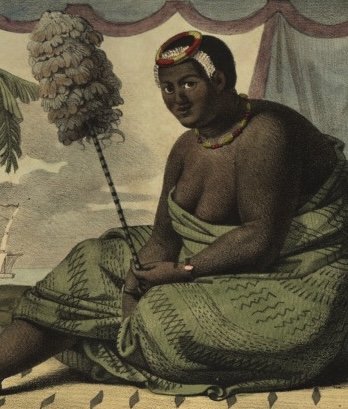European merchants made frequent visits to the Hawaiian islands once Captain James Cook documented its location in 1778. Not only was it an ideal source of resupply for whaling ships, it was also a convenient stop gap between Canton, China and the western coast of the Americas, major nodes in a prestigious and growing trade network. Merchant ships traded furs, sugar, and coffee for Chinese items like silk, tea, silver, and spices.
Agents of these trade corporations, like the Hudson’s Bay Company, as well as their suppliers, set up shop in Hawai’i throughout the late 1700s and early 1800s. Unlike many of the lands Europeans rediscovered around the globe, the Hawaiian islands were consolidated politically under a single royal government. Merchants made deals with the royal family or Ali’i or Konohiki (subordinate chiefs), to acquire land. This property was revocable at any time and was still technically owned by the Hawaiians they’d contracted with.
Missionaries, as in other frontier regions of Euro-American societies, were not far behind the merchants. The first missionaries arrived in the 1810s and 20s. As in other locales, their method of Christianizing indigenous populations centered around European style agriculture and property ownership. In these early decades of the 19th century there was much antagonism between merchant and missionary communities, each blaming the other for encouraging vice and discouraging proper industriousness among the Hawaiian commoners. After the American Board of Commissioners for Foreign Missions (ABCFM) revoked funding for the Hawaiian missionaries after an economic downturn in 1837, they became more amenable to large scale plantations, rather than the small scale farming they had administered previously.
Queen Ka’ahumanu. 1822. Jean-Pierre Norblin de la Gourdaine after painting by Louis Choris. Public Domain.
Kamehameha the Great had several wives. The most influential was Ka'ahumanu. She was born on the island of Maui to an elite family. Upon the king’s death, she informed his council that the king had wished her to rule alongside his named successor. The council created the title of kuhina nui, a sort of prime minister position. Kamehameha II, the former king’s firstborn son (not with Ka’ahumanu) reigned from 1819-1824. He died of measles while visiting London. As his brother and successor, Kamehameha III was only 10 at the time of his ascension, Ka’ahumanu continued her role as regent of the kingdom until her death in 1832. She was one of the primary elite Hawaiians to embrace Christianity and instigate reforms of traditional practices. This was not universally welcomed among Hawaiians, elite or commoners, but she had considerable influence over enough of the population that her leadership in this area was either accepted or cautiously tolerated.
Kamehameha III in military uniform. Alfred Thomas Agate. 1838-42. Public Domain.
Kamehameha III hired numerous European and American advisors to assist him with foreign trade and increasingly became convinced it was in his kingdom’s and his people’s interests to reform his dynasty as a constitutional monarchy modeled on the British system with a 3-branch government system. It is impossible to say for certain why he took this course, but there were many possibilities. As he came of age, many islands in the Pacific, such as New Zealand and Tahiti were claimed by the British and French Empires. Kamehameha III had his own brush with a hostile takeover when Lord George Paulet was sent to secure British possessions on the islands, and instead took the opportunity to claim the islands themselves for Britain. The king explained that he had already sent emissaries to settle these disputes, but Paulet was unmoved and threatened to open fire on the island. Under duress, the King yielded to Paulet, who raised the British flag over Hawaii. This episode only lasted 5 months, as Paulet’s superiors were outraged by the act and soon restored Hawai’i’s sovereignty.
Many historians argue that incidents like these, as well as the high mortality of native Hawaiians to European diseases, convinced Kamehameha III and much of the Hawaiian elite that colonization was inevitable and that the best way to safeguard their land was to convert the kingdom to a constitutional monarchy with a system of land ownership that a colonizing Western power would recognize. Most of the king’s British and American ministers encouraged this view. It should be mentioned that they and other White residents stood to gain immensely by such changes, whether colonization occurred or not.
The Constitution of 1840 formally converted Hawai’i to a constitutional monarchy. In 1845 a land commission was established to process land claims by all of Hawai’i’s residents, native and foreign. This process took until 1855 to complete. It is known as the Great Māhele (ma-hail-ay). While intended to safeguard the lands of all Hawaiians, we will take a closer look at how the Māhele fell short of its goal.
Sources:
Ka’ahumanu- Punahou School
Paulet Episode 1843- Ka’iwakīloumoku
Aftermath: the 1840s and Resistance- Punahou School

